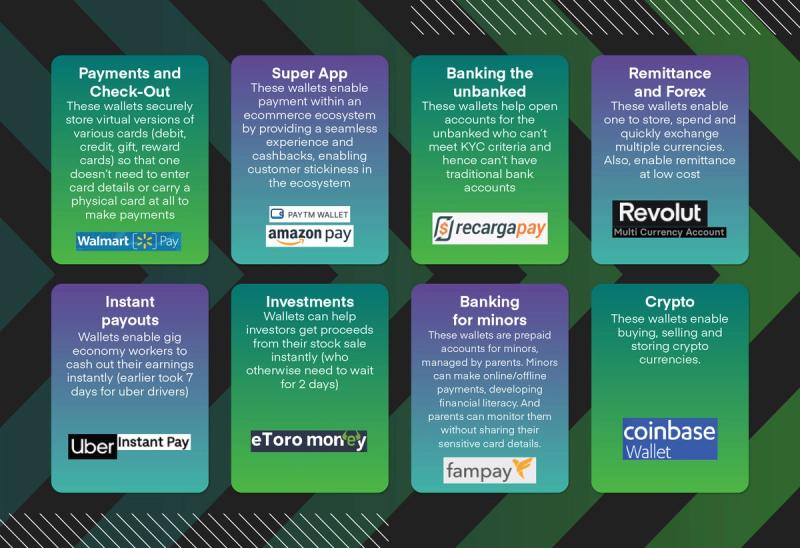The number of unique digital wallet users stood at 2.6 billion in 2020, a figure that is expected to surpass 4.4 billion globally in 2025. Separately, the total spend via digital wallets stood at $5.5 trillion in 2020 and is expected to exceed $10 trillion in 2025. This explosive growth reflects the value that digital wallets offer to both consumers and businesses.
Fuelled by the rise of smartphones, e-commerce and contactless payments, digital wallets have migrated from alternative to mainstream in a very short time.
Download our new research Digital wallets: How to get your slice of a $10 trillion industry to learn how businesses like yours, whether a bank, a fintech or a non-bank, can reap the benefits of this lucrative and highly customer-centric opportunity.

- Wallets offer convenience: Digital wallets enable customers to enjoy a more simplified shopping experience (i.e., no carrying wallets, counting cash, managing loose change, etc). Also, Digital wallets allow for more simplified onboarding and verification processes than traditional financial services providers, making it more convenient to use financial services.
- Wallets enable access to financial services for the unbanked and minors: Globally, about 1.7 billion adults remain unbanked, in addition to the 1.3 billion minors. Wallets provide a form of electronic money to those who otherwise cannot access traditional bank accounts. Additionally, wallets can act as a gateway product that can open the door to more complex products (e.g. build credit score for loan approvals, remittance, investments).
For businesses, digital wallets help enhance sales by boosting customer acquisition, improving sales conversion and making new customer segments more viable
- Wallets are a low-cost way to acquire customers: Because of their low risk to deploy and high frequency interaction, wallets are a good first entry point to acquire customers, many of whom can later be monetized via other services such as loans or insurance. A good example is Mach, a Chilean digital bank. Mach acquired customers by offering e-wallets and later employed the data acquired from the wallet to offer BNPL financing to the customers.
- Wallets improve sales conversion at checkout : For instance, Amazon Pay’s one-click-buy helps decrease shopping cart abandonment by ~17% . This happens as wallets help provide a seamless experience to the customer, and also because companies use the data collected by wallets to draw more insights about customers. As a result, companies can target customers better.
- Wallets allow serving underserved segments : Digital wallets have less stringent KYC regulations, flexible technical capabilities and lower costs of service, all of which enable them to serve the unbanked and minors – segments that are not often viable to serve at traditional banks because of regulations, legacy technologies and high cost of service . For instance, in southeast asia, More than 6 in 10 Southeast Asians are unbanked or underbanked. Grab pay is trying to serve this underserved population.
This dual value for both consumers and businesses has led to widespread adoption of wallets across industries and functions, creating innovative use cases. The top use cases, which form the majority of wallet implementations, include:

These use cases are not only relevant for financial institutions but also enable non-traditionals (i.e., retailers, telcos) to enter into financial services. For instance: Airtel, a telecom provider, launched a wallet to target the large unbanked population in India and provide payment services for utilities to the masses. Another example is Sonae, a Portuguese retailer, whose Universo program merges its store and partner loyalty and payment cards into one card. Sonae uses the program to improve retention and provide financial services (i.e., loans, insurance).
At Mambu, the inherent flexibility provided by our banking platform enables clients to easily build and scale these and other digital wallet use cases. Mambu’s banking platform has enabled our customers to generate faster time-to-revenue, serve new customer segments and expand across new products.
- Serve new segments: Ualá, a successful payments and lending solution catering to unbanked and young adults across Latin America, used digital wallets to develop and launch new value propositions to teenagers and micro merchants in less than a year.
- Launch new products: MACH already had ~3M customers using their e-wallets within Mambu. They chose Mambu to offer their e-wallet customers more products and services such as loans to finance purchases in instalments.
Because of their value proposition for both businesses and consumers, wallets today have become vital to businesses. The key question is what is your business going to do about it?
Learn more in our latest research Digital wallets: How to get your slice of a $10 trillion industry.
